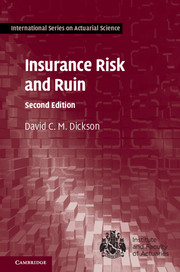Book contents
- Frontmatter
- Dedication
- Contents
- Preface
- 1 Probability Distributions and Insurance Applications
- 2 Utility Theory
- 3 Principles of Premium Calculation
- 4 The Collective Risk Model
- 5 The Individual Risk Model
- 6 Introduction to Ruin Theory
- 7 Classical Ruin Theory
- 8 Advanced Ruin Theory
- 9 Reinsurance
- Appendix
- Solutions to Exercises
- References
- Index
1 - Probability Distributions and Insurance Applications
Published online by Cambridge University Press: 17 November 2016
- Frontmatter
- Dedication
- Contents
- Preface
- 1 Probability Distributions and Insurance Applications
- 2 Utility Theory
- 3 Principles of Premium Calculation
- 4 The Collective Risk Model
- 5 The Individual Risk Model
- 6 Introduction to Ruin Theory
- 7 Classical Ruin Theory
- 8 Advanced Ruin Theory
- 9 Reinsurance
- Appendix
- Solutions to Exercises
- References
- Index
Summary
Introduction
This book is about risk theory, with particular emphasis on the two major topics in the field, namely risk models and ruin theory. Risk theory provides a mathematical basis for the study of general insurance risks, and so it is appropriate to start with a brief description of the nature of general insurance risks. The term general insurance essentially applies to an insurance risk that is not a life insurance or health insurance risk, and so the term covers familiar forms of personal insurance such as motor vehicle insurance, home and contents insurance, and travel insurance.
Let us focus on how a motor vehicle insurance policy typically operates from an insurer's point of view. Under such a policy, the insured party pays an amount of money (the premium) to the insurer at the start of the period of insurance cover, which we assume to be one year. The insured party will make a claim under the insurance policy each time the insured party has an accident during the year which results in damage to the motor vehicle, and hence requires repair costs. There are two sources of uncertainty for the insurer: how many claims will the insured party make, and, if claims are made, what will the amounts of these claims be? Thus, if the insurer were to build a probabilistic model to represent its claims outgo under the policy, the model would require a component that modelled the number of claims and another that modelled the amounts of these claims. This is a general framework that applies to modelling claims outgo under any general insurance policy, not just motor vehicle insurance, and we will describe it in greater detail in later chapters.
In this chapter we start with a review of distributions, most of which are commonly used to model either the number of claims arising from an insurance risk or the amounts of individual claims. We then describe mixed distributions before introducing two simple forms of reinsurance arrangement and describing these in mathematical terms. We close the chapter by considering a problem that is important in the context of risk models, namely finding the distribution of a sum of independent and identically distributed random variables.
- Type
- Chapter
- Information
- Insurance Risk and Ruin , pp. 1 - 26Publisher: Cambridge University PressPrint publication year: 2016



